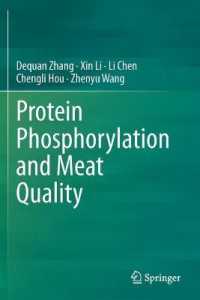Full Description
This book provides a comprehensive overview of state-of-the-art applications of nanotechnology in biology and medicine, as well as model organisms that can help us understand the biological activity and associated toxicity of nanoparticles, and devise strategies to minimize toxicity and enhance therapies.
Thanks to their high surface-to-volume ratio, nanoparticles are characterized by excellent biocompatibility and bioavailability, a high therapeutic index, and relatively low toxicity, which has led to their widespread application in the early diagnosis of diseases, comprehensive monitoring of disease progression, and improved therapeutics.
The book also explores nanoparticle-based insecticides and their mechanisms of action, and provides a comparative analysis of the various model organisms that are used to understand the biological properties of nanoparticles. Further, it describes various in-vivo models that yield important insights into nanomaterial-mediated toxicity, promoting the optimal utilization of nanoparticles. In closing, the book discusses future perspectives and regulatory issues concerning the use of nanomaterials in translational research.
Contents
Chapter 1. Nanotechnology : Application in biology and medicine.- Chapter 2. Biological activities of nanoparticles and mechanism of action.- Chapter 3. Application of nanoparticles in Drug delivery.- Chapter 4. Antimicrobial activity of metallic nanoparticles using prokaryotic model organisms.- Chapter 5. Modelling nanoparticles parameters for antibacterial activities.- Chapter 6. Saccharomyces cerevisiae as model organism to study biological activities of nanoparticles.- Chapter 7. Investigation of Biological activities of Nanoparticles using Cell Lines.- Chapter 8. Caenorhabditis elegans: a model organism to decipher biological activities of nanoparticles.- Chapter 9. Zebra fish model system to investigate biological activities of nanoparticles.- Chapter 10. Drosophila melanogaster - A model organism to understand biological activities of nanoparticles.- Chapter 11. Understanding the biological activities of nanoparticles using murine models.- Chapter 12. Insecticidal activitynanoparticles and mechanism of action.- Chapter 13. Routes of Exposures and Toxicity of Nanoparticles.- Chapter 14. Toxicological evaluation of nanoparticles using prokaryotic model organisms.- Chapter 15. Evaluation of Toxicity Nanoparticles using Cell lines.- Chapter 16. Saccharomyces cerevisiae : Model organism to evaluate nanoparticles toxicity.- Chapter 17. Caenorhabditis elegans: Evaluation of nanoparticle toxicity.- Chapter 18. Zebra fish: A laboratory model to evaluate Nanoparticle Toxicity.- Chapter 19. Evaluation of toxicity of nanoparticles using Brine Shrimp.- Chapter 20. Drosophila Model to Decipher the Toxicity of Nanoparticles.- Chapter 21. Murine models to understand the toxicity of nanoparticles.- Chapter 22. Challenges and future perspectives of Nanotoxicology.








